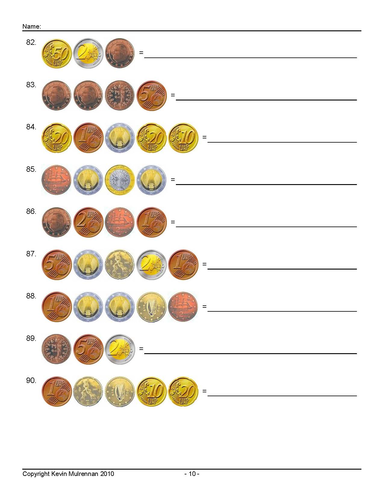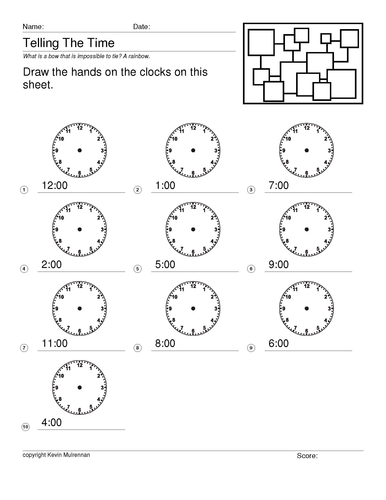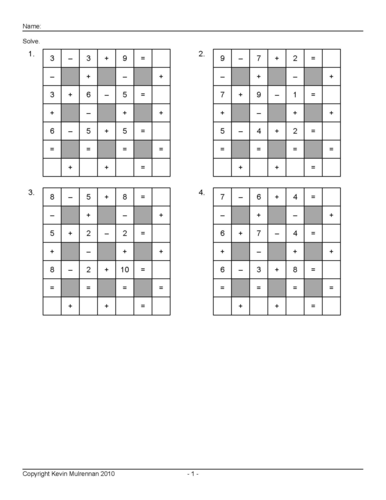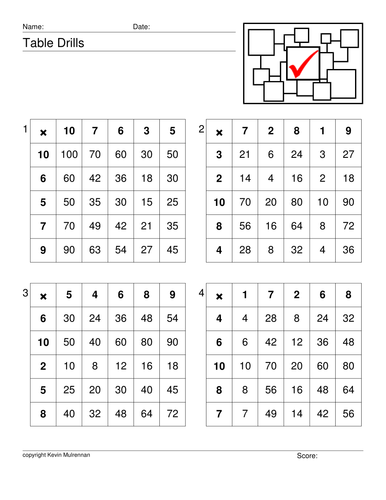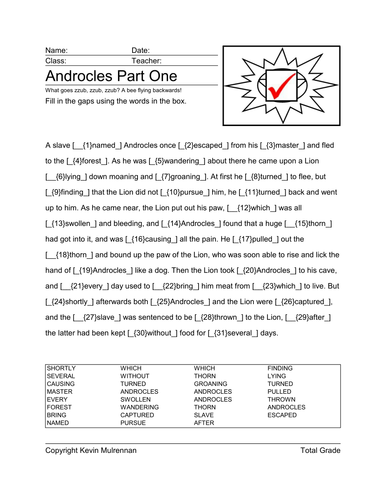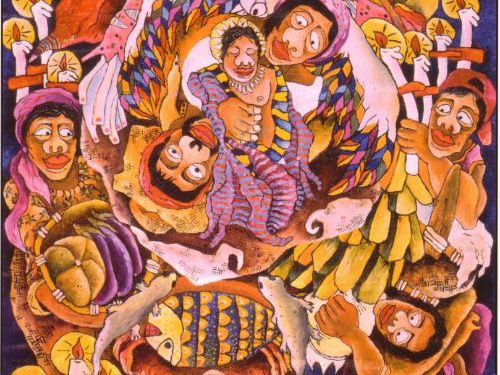351Uploads
96k+Views
27k+Downloads
All resources

Freebie Free 5 Worksheets Maths Shopping Arithmetic KS1 KS2 Money Counting
A freebie.
If you like these I have 100 for sale in my shop.
I have designed 5 worksheets on Money and Shopping for primary school children. I have used a variety of items, a variety of difficulty and a variety of numbers of questions per sheet. Pupils write on the sheets the total cost. e.g. a milkshake costs £2.90 a hot dog £1.65 How much would 2 milkshakes and 3 hotdogs cost? There is plenty there to reinforce the work done in the classroom. Good for extra homework or additional work for the bright ones. Answer sheets are provided for all worksheets.

Freebie Telling Time KS1 KS2 Mathematics Clocks Minutes Hours
A sheet where pupils have to put the correct times in.
If you like this, please visit my shop where you can buy a full set.

Freebie 2 French Wordsearches KS1 KS2 Perfect for Friday Afternoons With Answers
2 French wordseaches with answers.
Each one has 20 basic words to find.
Perfect for rainy Friday afternoons, homeworks etc.
If you like these, please visit my shop where you can purchase 500 of these at a very reasonable price.

Euro Coins Worksheets KS1 KS2 Mathematics Freebie
A worksheet that pupils have to fill in. They have to add up the coins.
If you like it, please visit my shop that has an enhanced similar product.

Freebie Fractions KS1 KS2 Mathematics Simplifying Mixed Fractions etc
An example freebie of my self-designed fractions sheets.
If you like this one, please take a look at my shop.
You could but half a million questions on fractions.
Or maybe ones on simplifying fractions, Mixed fractions etc.
Please look for the bundles if you are looking for great value.

Freebie Telling the Time KS1 KS2 Mathematics
A sheet with answers where pupils have to draw the hands to show the time on a small clock.
If you like this, please visit my shop where there is a more sophisticated product.

Maths Puzzle Across Down Addition and Subtraction Puzzle Plus Answers
Great for reinforcing maths.
Across-Downs is a fun activity that reinforces addition and subtraction skills.
The object of the exercise set is to find the answer for each row and column, then use those answers to calculate the final answer in the lower right-hand corner of the puzzle.
This tests addition and subtraction.
If you like this freebie, please visit my shop which has loads of puzzles for sale. Buy the bundles for best value.

Table Drills Mathematics Multiplication KS1 KS2 Maths Freebie Free
If you like this resource more available in my shop.
Fill in the gaps to get the correct multiplication answer.

Aesop Fable Cloze Test Androcles Classics Latin
A cloze test on an Aesop fable.
If you like this one I have a collection in my shop.
You get many, many more of them at a reasonable price.
Great timefiller for Froday afternoons or homework.
If you like the product, please leave a good review, especially as it’s FREE! Thank you!

Latin Word Search Freebie plus answers Cambridge Latin Course
A freebie.
A Latin word search.
If you like this one, I have 500 for sale in my shop.

Christmas Powerpoint Free Freebie Lesson Taster Advent Religious Studies
A freebie.
A nice powerpoint on the religious aspect of Christmas.
I’m hoping to interest you in buying my series of Christmas lesson on R.E.

Free Freebie Good Samaritan Lesson Simple and Effective for Year 4 R.E. Literacy
Got me a job so must be reasonable!
A simple lesson plan, worksheet, powerpoint.
Great for discusiing with pupils.
I have plenty of maths, literacy, languages and Literacy stuff so have a look after downloading this freebie.
Sale

Year 4 English Maths planning kr Short and Medium
Collected together my year 4 lesson planning from outstanding academy.
Mainly English and Maths.
sample:
Tuesday 31.01.12
LO: To understand how the use of expressive and descriptive language can create effects or generate emotional responses.
Read a descriptive/emotive poem ( Poems Not To Missed)
JBA & JP to model how to express how the poem made us feel and what impact the vocabulary choices had on us and why?
Read two poems that are expressive and descriptive.
Ask chn What was your immediate reaction? Which vocabulary choices were effective and had impact? Why? What emotions do you get from the poems? What images did you get from the poems?
Wednesday 01.02.12LO: To plan an ICT-based poetry presentation that involves each member of the group
Recap leaning - What are they learning? What have they learnt about poetry texts? Why is learning about poetry important? How could you use what you have learnt about performing poetry?
Inform chn that they are going to plan a poetry presentation. Discuss What is a poetry presentation? What is the purpose of a poetry presentation? How are poetry presentation put together?
Explain that they are going to promote a poem using key language/emotions from the poem.
In talk partners discuss what makes ‘good’ poetry? JP/JBA to scribe chn ideas on ‘working wall’
Using visual Literacy watch clips from poetry readings that the chn have watched previously. Ask:
What makes the poem a ‘good’ poem and why? Can you identify key language/emotions/rhythm in the poem that would entice others to read the poem and why? How would you go about putting the key language/emotions together to create a poetry presentation? JP/JBA to scribe chn ideas on ‘working wall’
JBA & JP model how we plan to put together a poetry presentation for a poem we have read. Explain that a presentation is to demonstrate the understanding of a poems’ key message.
Show what we are thinking when planning a poetry presentation. Which parts of the poems’ language was effective? What was the most emotional verses and why? Which verse has rhythm? How could we present this poem through drama? Thought shower ideas on working wall.
Sale

year 1 Literacy Fantasy World Planning
Three great powerpoints.
Two great flipcharts.
Planning.
Sample:
Discuss fantasy settings we know so far as a whole class using Fantasy PP 1.
Reinforce the concept of a fantasy setting by showing lion, witch and wardrobe where child walks into Narnia clip:
http://www.youtube.com/watch?v=JMYU5vSaal8
In talking partners discuss adjectives describe the setting. Beach ball/Bean bag ideas.
Feedback to group.
Recap yesterday’s learning. Then use the Fantasy PP 2 and go through with the children how to create their own fantasy world.
Explain the activity – children to create on paper their own fantasy world and label it.
Must include:
Setting
Characters
Magical objects
Watch the clip from Harry Potter in the magic shop and encourage the children to look out for all the magic objects: http://www.youtube.com/watch?v=hDR5XgHHLBY and http://www.youtube.com/watch?v=szEFdhOHtrI (0-40 seconds)
Make a list of all the objects they could see, what they could be for, using Fantasy PP 3.
Explain the activity; children will be creating a magic object from their setting they created yesterday or a new one. What does it look like? What is it called? Etc
Sale

Year 6 English Maths Planning Gunpowder Plot
Lots of planning for all three terms.
Maths and English mainly but arts stuff and History too.
sampl:
Text: The Gunpowder Plot
Genres covered in this unit:
• Predictions
• Inference (How? Why?)
• Newspaper features
• Journalistic writing
• Letter writing
Key teaching input/texts/questions/
clips etc
BOOKS
Display an image from the front cover of the book and discuss what children already know. What does it look? What do you think will happen? What can you see in the picture? Share and discuss, make notes for working wall.
Show children the entire cover of the book. Identify the 5Ws; who? What? Where? When? Why? What is the title? What do you think will happen? Note 5ws for working wall.
Show children the grid for likes, similarities and puzzles, Identify one for each section and explain why I chose it.
Whole class discussion of extra hot challenge.
Resources:
Book cover
Images from book cover
Grid sheet
JOTTERS
Review previous learning – refer to working wall. What do you think will happen? Who will be involved? Where will it happen? Why does it happen? When does it take place? Share predictions.
Introduce the text to the children. Read first 4 pages and ask questions linked to the text.
Children to read through/skim read to identify the 5Ws – record for the working wall and compare with predictions. Was anyone close with their prediction? Why might this be?
Share video with children: https://www.youtube.com/watch?v=YptNONmnXH0 Discuss key events. What do you think will happen next? Make predictions in jotters and share.
Sale

Year 1 Maths English Planning
Planning for English and Maths. 56 files.
sample:
Text:
This is the bear and the scary night
Genres covered in this unit:
Narrative SPAG focus:
Monday: spelling patterns
Tuesday: use and to join clauses
Wednesday: high frequency words
Thursday: high frequency words
Friday: time connectives
Key teaching input/texts/questions/
clips etc Steps to Success
Read the story This is the Bear and the scary night
Discuss character, setting, key events etc…
Discuss what happened in the beginning, middle and end of the story. Explain to the children that this week they are going to write their own story similar to the bear and the scary night.
Ask children to describe their character to their partner (can be their favourite toy or the teddy they bought into school on Friday).
Ask children to share their ideas about their story.
What is the setting?
What are the characters doing?
What is the problem?
How are the characters feeling?
How does your story end?
Mild: describe your main character
Spicy: share your ideas with your partner
Hot: listen attentively to your partner
Extra Hot: Act out key events from your story
LA Activities MA Activities HA Activities
Read to Write
Mrs Preston Phonics
Mrs Simpson Talk for writing and act out their story
Photos for books
Resources: The bear and the scary night book, cards with questions
Give 3 minutes for children to recap their story.
Who is their main character?
What happens at the beginning, middle and end of the story?
Model how to put key ideas onto their plan.
Steps to Success
Mild: recap your story with your partner
Spicy: Identify the beginning, middle and end of your story
Hot: Write key ideas onto your story plan for the beginning, middle and end.
Extra Hot: Check your partner’s plan is sequenced correctly
Sale

Year 2 English Maths Planning Plus History World war 2
Lots of English and Maths. Tremendous amount of stuff on World War 2.
Text: Room on the Broom. We will also share a variety of Julia Donaldson texts with the children at the end of each day to support and promote new learning and understanding.
Genres covered in this unit: Non-Narrative. Grammar focus:
Monday: Using a capital letter to start a name: Julia Donaldson.
Tuesday: Using a question mark at the end of a question.
“How many books have you written?”
Wednesday: Writing a clear sentence using a capital letter and a full stop.
Thursday: Writing a clear sentence using a capital letter and a full stop.
Friday: Writing a clear sentence using a capital letter and a full stop.
Key teaching input/texts/questions/
clips etc Steps to Success
Teacher to display a picture of Julia Donaldson on IWB.
Q: Who do you think this is? What do you think she does for a living? Why? - Teacher to encourage pupils to expand on their answers/thinking. Teacher to explain that this woman is called Julia Donaldson and she is a children’s author. Class to work together to list stories from this author using reading area to support. E.g. The Gruffalo, The stick man, Room on the Broom…
TTYP: Can you think of 3 questions that you would like to find out about this author? – Class to share ideas and Teacher/TA to scribe to support future learning.
Using the following website, Teacher to carry out shared reading with the class to discover new information/answer any questions e.g. “How many books have you written” : http://www.juliadonaldson.co.uk/index.php
Mild: state something you would like to find out about Julia Donaldson.
Spicy: use phonetic knowledge to segment and blend CVC/ CVCC words
Hot: share an interesting fact you have found out about Julia Donaldson.
Extra Hot: Would you like to be an Author? Why?
Sale

Year 3 Maths English Planning Topic work on China
English and maths planning. 39 files
Text: ARCHIES WAR – Marcia Williams
Genres covered in this unit: 2 weeks - character descriptions – to include descriptive settings
Letter writing, information texts and propaganda posters.
Children have white boards. I will describe a person and you must draw them From the twits Roald dahl(Mr Twits). Children share ideas from the first opening paragraph. What made this so visual. LANGUAGE
Look at a series of images. Witch, doctor, pirate.
Look at the features, are there similarities.
Elaborated pictures of people. Famous and non famous.
Discussion and focal point.
Play head band with the children. They have to describe the person they are holding and the partner has to guess who it is.
Expanding on words to describe Steps to Success
Mild: To review characters
Spicy: To recognise features of a character
Hot: To describe your character
Extra Hot: How could you describe yourself? Tell me.
Sale

Year 5 Planning English Maths Geometry Haiku
Planning from an academy. Spread over the three terms.
Lots of planning. Worksheets. Powerpoints.
Mainly English and Maths.
Zip has the lot. ive included plenty in the general download to give you an idea of content.
sample :
Explore children’s understanding of the term angle and record on working wall. Where have they seen angles? What do angles look like? What are they measured in? Following knowledge harvest, explain that this term will focus on measuring, drawing, classifying angles. Ensure children can identify the key features of a protractor. Use enlarged version and annotate key features on WW.
Ensure that the children can explain angle types and their properties. This will be useful when checking measurements.
Explore strategies for measuring angles using enlarged models and enlarged protractor.
Have the children measure angles to the nearest 10, 5 and degree. Identify difficulties when alignment is inaccurate. Model the use of known angle types to check accuracy of measurement.
Discuss with pupils what they now know about the structure and style of a haiku poem.
Model for pupils a haiku poem based upon the topic of water (links to Rivers topic, Finding Nemo setting and this week’s setting work)
Then re write after making changes.
Pupils to share their completed work
Steps to Success
Mild- to record ideas for a Haiku poem about water
Spicy- present poem in the form of a Haiku
Hot- to read over my own work and propose changes to grammar and vocabulary, spelling and punctuation ( CAGS 3 / 4)
Extra Hot- selecting appropriate grammar and vocabulary and understand how such choices can change and enhance meaning. ( CAG 5/6)
Sale

Year 5 English Maths Planning kr
Gathered up my pland for year 5 from a great academy school.
Mainly English and maths.
sample:
To use multiplication methods to multiply TU × U or HTU × U.
On the board have a question: 76 x 4=?
On their whiteboard ask the children to solve this. If they don’t know this then they don’t need to worry as I will be teaching them. Highers do 675 x 3=?
On the progress board tally how many can do this.
Teach them how to use the multiplication method. They follow in their yellow books.
To use written methods to divide whole numbers.
Ask the children who can divide 87 by 3? Highers do 87 by 4?
Fill in the progress chart.
Show them the chunking method. Hayley takes SEN out to show them how to use the number line to divide.
Children follow in their yellow rough books. If the children understand it they carry on independently. Those that don’t sit there and follow until they understand.
Targets.
Ask the children who thinks they can achieve their targets now at the beginning of the lesson? Ask those who can’t remember them to look now in the front of their book.
To know the key features of arguing a point of view.
Link the reading with the work the group has been doing for the last two weeks.
Introduction _ Explain that this week the group will be looking at another context for persuasive writing – presenting an argument in a letter.
_ Discuss what the children have found out about persuasive texts.
_ Read children their target for the week: ‘I am learning to organise my writing to present information clearly.’ Today they are going to see how one writer has done this.
_ Explain that when reading ‘What a rip off’ you want the group to think about two things: (1) how the argument is structured, and (2) the language features.
Read What a Rip Off.




